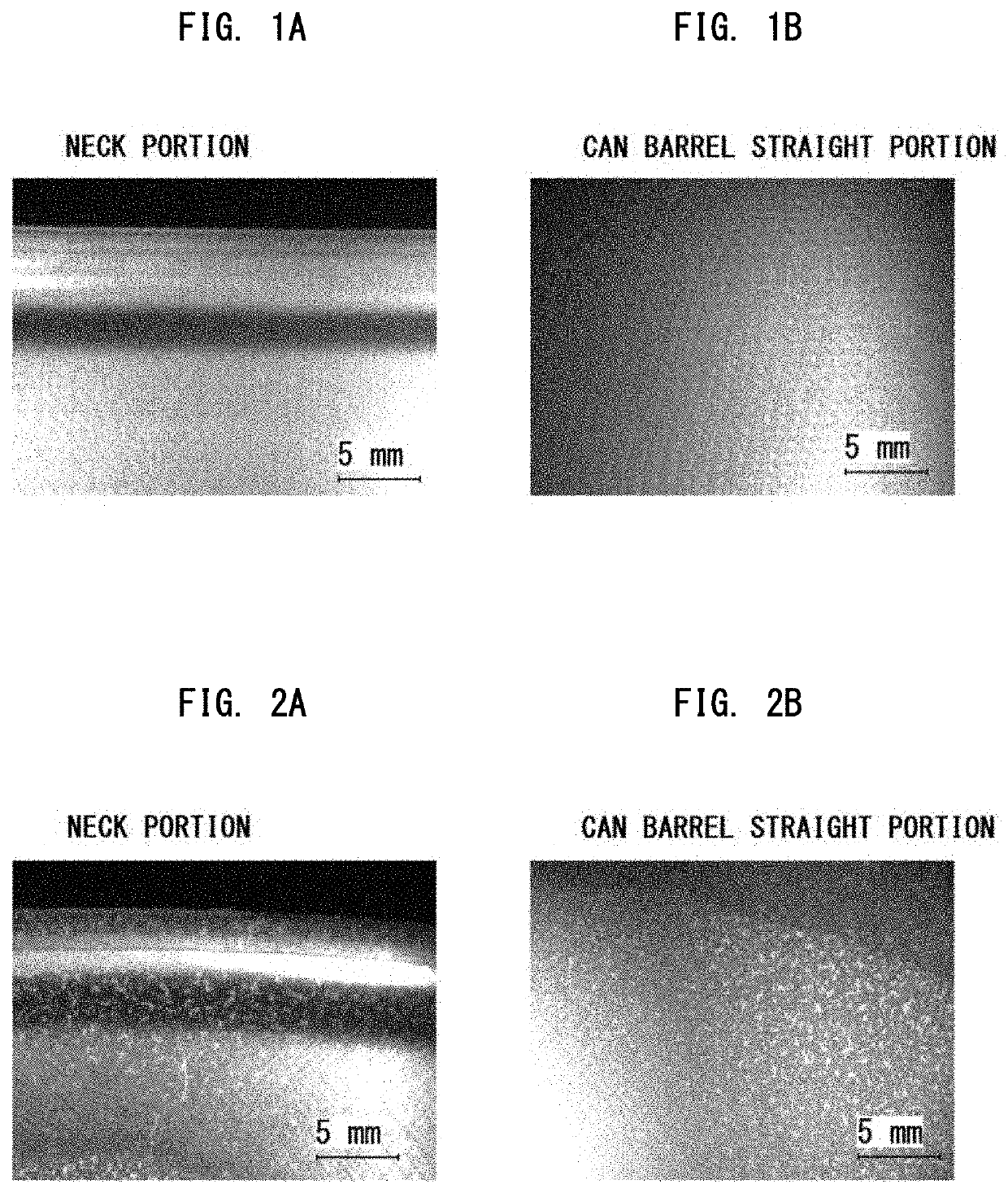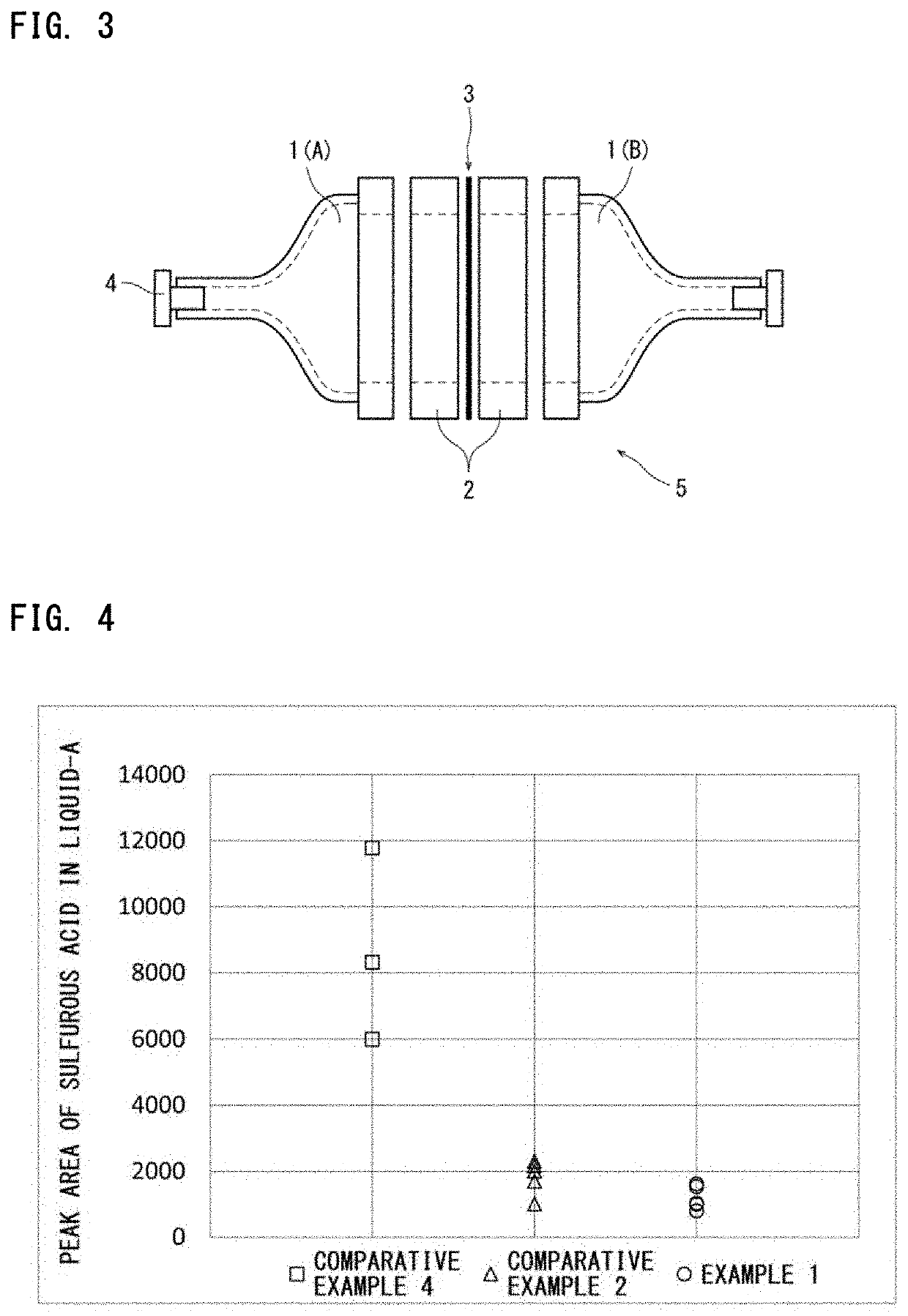Aluminum wine container
a wine container and aluminum technology, applied in the field of aluminum wine containers, can solve the problems of easy oxidation of wine, easy impairment of flavor, corrosion of metals, etc., and achieve the effects of preventing aluminum corrosion and flavor deterioration, excellent handling ability, and excellent productivity and economic efficiency
- Summary
- Abstract
- Description
- Claims
- Application Information
AI Technical Summary
Benefits of technology
Problems solved by technology
Method used
Image
Examples
experimental example 1
[0067]Each of the containers of Example 1 and Comparative Example 4 shown in Table 1 was filled with white wine (pH: 3.4, free sulfurous acid concentration: 80 ppm, total sulfurous acid concentration: 225 ppm) and sealed. The packed wine was stored for six months under a constant temperature condition of 23° C., and then, the can inner surface was observed. In the container of Example 1, corrosion was evidently prevented.
[0068]FIG. 1 (Example 1) and FIG. 2 (Comparative Example 4) each consists of a set of photographs showing a can inner surface after six months. FIGS. 1 (A) and 2 (A) show the neck portions and FIGS. 1 (B) and. 2 (B) show the can barrel straight portions.
experimental example 2
[0069]The seamless cans manufactured in Example 1 were fill ed with white wine (pH: 3.2, free sulfurous acid concentration: 30 ppm, total sulfurous acid concentration: 105 ppm), each of which was sealed with any of three types of aluminum can lids having inner surfaces applied with different coating films as shown in Table 2 below. The packed wine was stored for three months under a constant temperature condition of 23° C. or 37° C., and then, the can inner surface was observed. For the lids with the polyester / phenolic coating films, corrosion was evidently prevented. On the lid with the inner coating film having a minimal thickness of 5 μm, corrosion occurred after three months under a constant temperature condition of 37° C. As for the lid with the inner coating film having a minimal thickness of 8 μm, no corrosion occurred in three month under the constant temperature condition of 2° C. or 37° C.,
TABLE 2Incidence of corrosion on lidAfter 3 monthsAfter 3 monthsLid typeat 23° C.at ...
experimental example 3
[0070]An inner surface resin film on the can barrel was isolated from each of the seamless cans in Example 1, Comparative Example 2 and. Comparative Example 1 so as to compare the amount of sulfurous acid permeation by using a spherical glass column chromatographic tube (OF-30 supplied by AS ONE Corporation) shown in FIG. 3.
[0071]An inner surface resin film 3 was fixed by sandwiching with a column 1 (A) and a column 1 (B) via packings 2 made of fluororubber. The column 1 (A) was filed with pure water, the column 1 (B) was filled with a citric acid solution containing sodium sulfite (pH:3.1, total sulfurous acid concentration: 500 ppm), and sealed with septums 4 made of silicon rubber.
[0072]After a one-week storage under a constant temperature condition of 23° C., sulfurous acid concentration in the pure water filled in the column 1 (A) was measured.
[0073]An ion chromatograph (ICS-2100 supplied by ThermoFisher Scientific) was used for sulfurous acid concentration determination. The r...
PUM
| Property | Measurement | Unit |
|---|---|---|
| Thickness | aaaaa | aaaaa |
| Thickness | aaaaa | aaaaa |
| Thickness | aaaaa | aaaaa |
Abstract
Description
Claims
Application Information
 Login to View More
Login to View More - R&D
- Intellectual Property
- Life Sciences
- Materials
- Tech Scout
- Unparalleled Data Quality
- Higher Quality Content
- 60% Fewer Hallucinations
Browse by: Latest US Patents, China's latest patents, Technical Efficacy Thesaurus, Application Domain, Technology Topic, Popular Technical Reports.
© 2025 PatSnap. All rights reserved.Legal|Privacy policy|Modern Slavery Act Transparency Statement|Sitemap|About US| Contact US: help@patsnap.com


